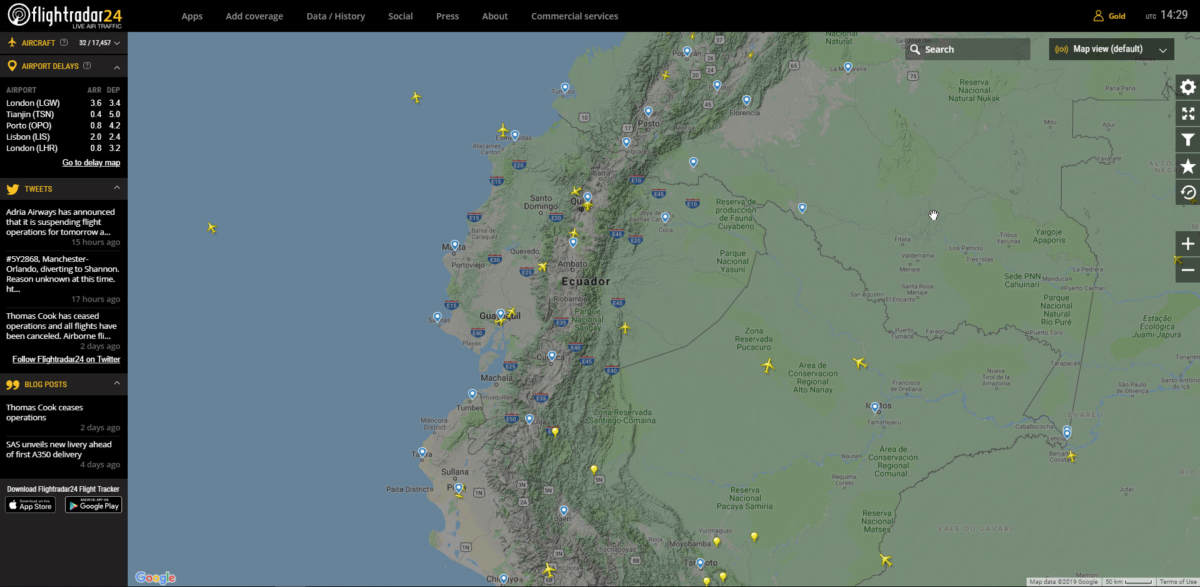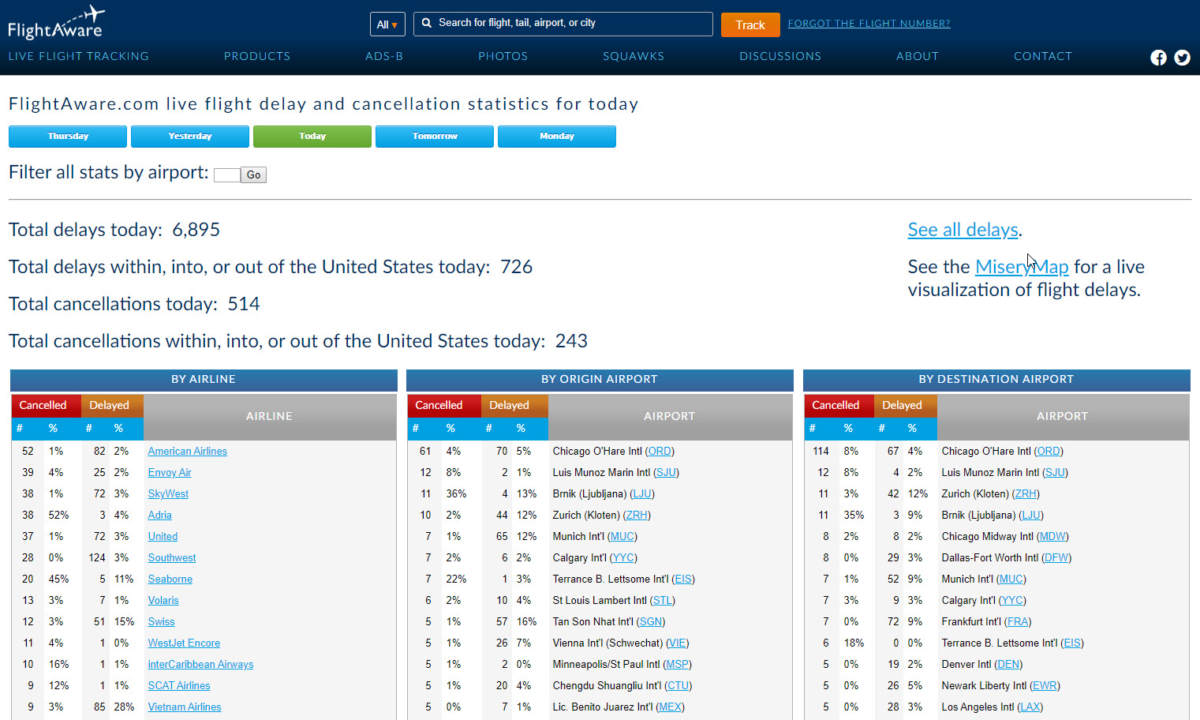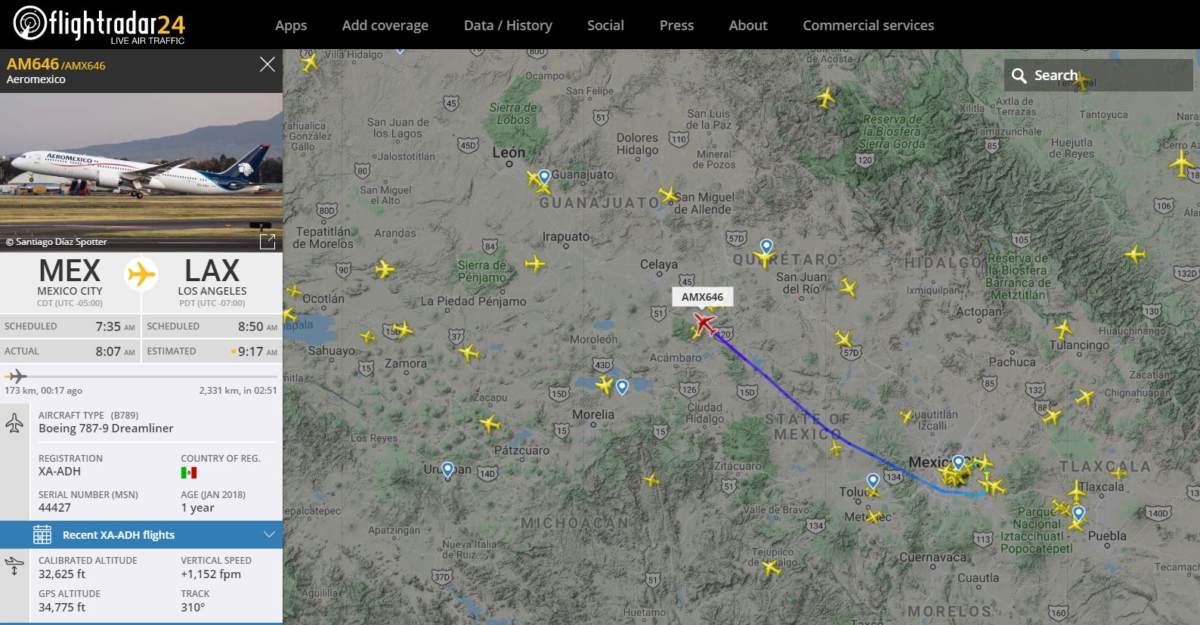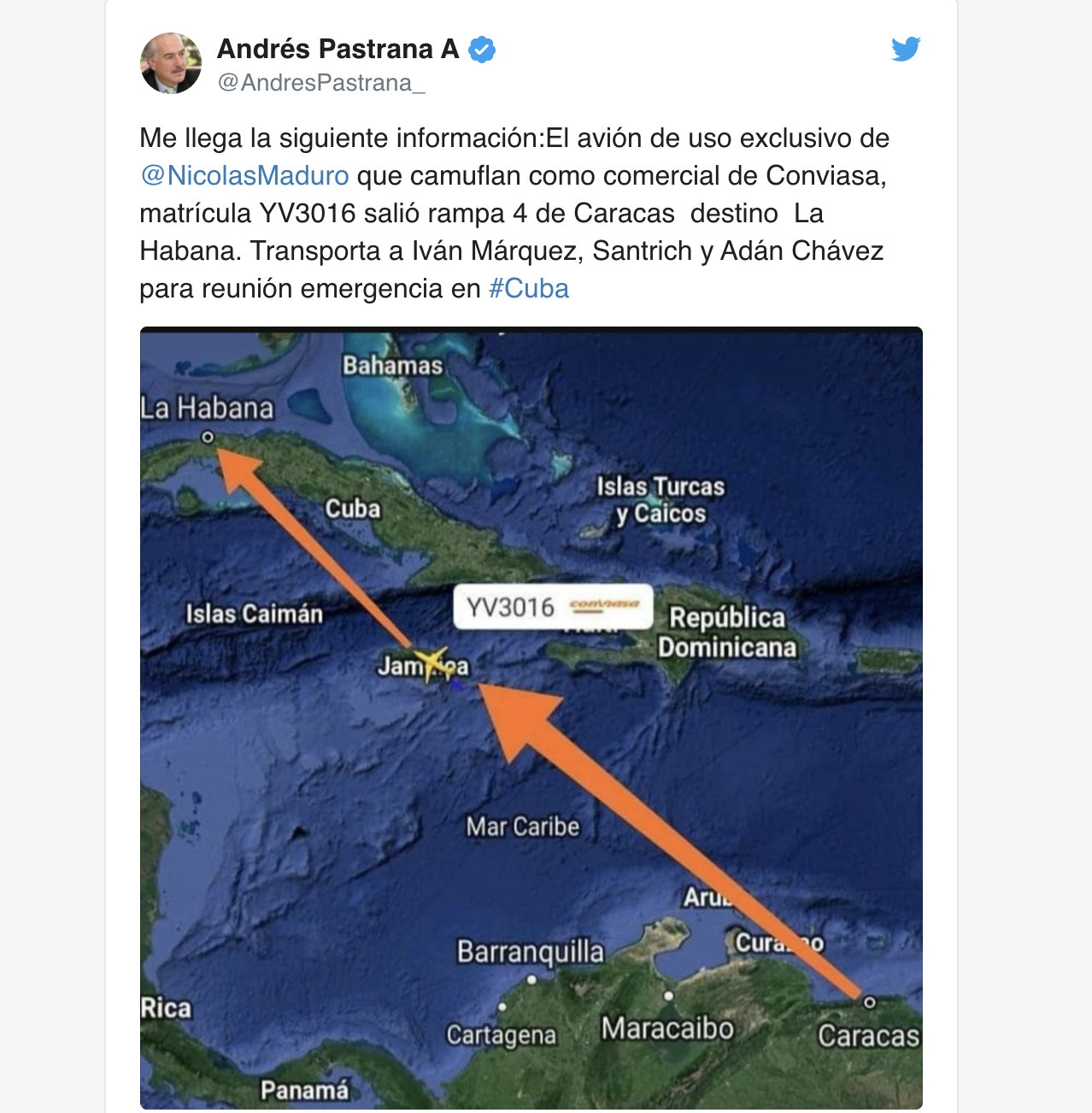A Beginner's Guide To Flight Tracking
Flight tracking is an accessible and useful tool for open source investigators. Being able to track the movements of aircraft belonging to powerful individuals and armed forces can add important details to stories, or even uncover entire new narratives. There are several commercial and hobby websites that allow us to do just that.
The purpose of this guide will be to get you up-to-speed on how to start tracking flights. By the time you finish this guide, you will be able to fire up your browser and start watching the virtual skies!
I will begin with a glossary of terminology needed to start tracking flights. Then, I will go over some of the most popular flight tracking websites out there and outline some of their features. Finally, the guide will conclude with a case study demonstrating how these tools can be used in conjunction with one another to shed light on the air movements of the powerful.
First, Some Terminology
Before exploring how to track aircraft, it is important to go over some terminology. Below is a glossary of the terms that we will be working with throughout the rest of this guide:
- Call Sign: The call sign is an identifier that an aircraft uses during a flight. While a private aircraft might use its registration number as its call sign, commercial flights tend to have call signs that are dependent on routes. For example, at the time of publishing, the call sign for Lufthansa’s Frankfurt-Orlando flight is LH464. This is the identifier that would be printed on your boarding pass if you were on that flight. Call signs can change often depending on the flight, and, in some rare instances, even mid-flight. In other words, the same airplane might have multiple call signs in a single day if it is carrying out many flights (i.e., Toronto to Montreal, then Montreal to Toronto, then Toronto to Ottawa, etc).
- Registration: The registration is the aviation equivalent of your car’s license plate. Whenever an aircraft is registered in a jurisdiction, it is assigned a registration. The registration is typically featured near the tail section of the aircraft. Which country an aircraft is registered in will partially determine its registration. For example, aircraft registered in Canada will have registrations that begin with the letter C; in France, registrations begin with the letter F, while in the United States they begin with the letter N (this is why in the United States, aircraft registration is often called the “N-Number”). For a list of aircraft registration prefixes by country, check out this Wikipedia article. Like with call signs, it is possible to change an aircraft’s registration. If person X has a private jet registered in Canada and sells it to person Y who lives in Germany, person Y may choose to register their new airplane in that country, which would mean it would be assigned a new registration by German authorities.
- Manufacturer Serial Number (MSN): The MSN is a unique number that is assigned to each aircraft on the factory floor. If the registration is the aviation equivalent of your car’s license plate, then the MSN is like the vehicle identification number that is assigned to a car by its manufacturer. Unlike the call sign and the registration, an aircraft’s MSN cannot change. This makes knowing an aircraft’s MSN important if you are trying to track it across many years and purchases. An aircraft might cycle through dozens of call signs and registrations, but its MSN will always remain the same (for a database of some MSN numbers, click here).
- ADS-B: ADS-B stands for “automatic dependent surveillance—broadcast”. It is the technology that allows open source investigators and enthusiasts to track flights on the websites that we will see in this guide. Aircraft the world over are increasingly equipped with ADS-B Out modules, which transmit unencrypted information that can be picked up by antennas on the ground. The equipment necessary to receive ADS-B signals is relatively inexpensive and easy to set up, and this allows flight tracking websites to exist. ADS-B technology is going to become more ubiquitous as time goes on, given its many advantages over the older, ground-based radar technology. For example, the U.S. Federal Aviation Administration (FAA) is requiring all aircraft flying in most controlled airspace to be equipped with ADS-B Out transponders by January 1, 2020.
Whether to focus on the call sign, the registration, or the MSN of an aircraft will depend on what it is that you are trying to achieve. If a loved one is visiting you and you want to track their flight, then the flight’s call sign is all you need. If you are trying to confirm whether an airplane registered to an individual was in X location at Y time, then the registration will be useful to you. Finally, if you want to trace how one aircraft has exchanged hands over the years, then knowing its MSN will help you do that.
Flight Tracking Websites
There are several websites that let you track flights, both live and through historical flight records. As with any other open source tool, it is advisable to check multiple websites since one might have more information than the others. Which website you decide to use as your default tracking page will depend on several factors, including subscription prices and interface preferences. These websites tend offer the same services and kinds of information, but as you start using them you might find that you prefer one over the others for personal reasons.
Sometimes, you will find that the flight you are looking for does not appear on a website. It could be that there is no record for that aircraft on that website, but there are other possible reasons as well. Remember that each website is “fed” by a different community of receivers, so a flight that does not appear on one page might appear on another. Sometimes, individuals or governments will request that these websites not show their flights for any number of reasons. This might result in flights being removed from the website, so keep that in mind while conducting research.
All the sites below (except for adsbexchange.com) offer tiered subscription packages, including a free basic tier that shows live air traffic, and limited flight details and historical flight information. For most users, the free basic tier will have all the information that you will need from a flight. If you do decide to sign up for a paid tier, the decision will likely come down to how far back in time you need historical flight data.
Flight Radar 24 (www.flightradar24.com)
Flight Radar 24 is one of the best-known flight tracking websites. The site’s default interface is clean (but customizable) and straightforward, making it a great choice for learning the ropes of flight tracking.
Like the other pages on this guide, Flight Radar 24 offers the ability to view historical flight records. In other words, if you were to search an aircraft’s registration, you would be able to find the records that the website has of flights that aircraft has made in the past. The page also offers a “Playback” feature that lets you view a given section of airspace as it appeared at some point in the past. This tool is useful in cases where you want to track activity at a particular airport and are less concerned with (or simply do not know) an aircraft’s registration.
Paid Subscription? Yes, in tiers.
- Basic Plan (free): Live flight tracking and 7 days’ worth of flight history.
- Silver Plan ($1.49 per month): More aircraft details and 90 days’ worth of flight history.
- Gold Plan ($3.99 per month): Even more flight details, and 365 days’ worth of flight history.
- Business Plan ($49.99 per month): The full arsenal of the pages’ aircraft data, including 730 days’ worth of flight history.
Radar Box (www.radarbox24.com/)
At fight sight, Radar Box looks a lot like Flight Radar 24. In many ways, it is. One small quality-of-life difference is that Radar Box’s default interface will show you more information when you hover your cursor over an airplane than Flight Radar 24. This information includes the airline’s logo, departure and arrival cities, aircraft type and registration number. If you are looking to get a quick survey of an airspace, this small feature can save a lot of clicking (Note: Flight Radar24 offers this feature as well with a little tweaking of its settings).
Paid Subscription? Yes, in tiers.
- Basic Plan (free): Live flight tracking and 7 days’ worth of flight history.
- Spotter Plan ($2.45 per month): Access to the premium mobile app, more aircraft details, and 30 days’ worth of flight history.
- Pilot Plan ($7.95 a month): Marketed to “pilots and ATC [air traffic control] controllers & dispatchers”, air traffic control boundaries, and 90 days’ worth of flight history.
- Business Plan ($39.95 per month): Includes a fleet tracking option, as well as 365 days’ worth of flight history.
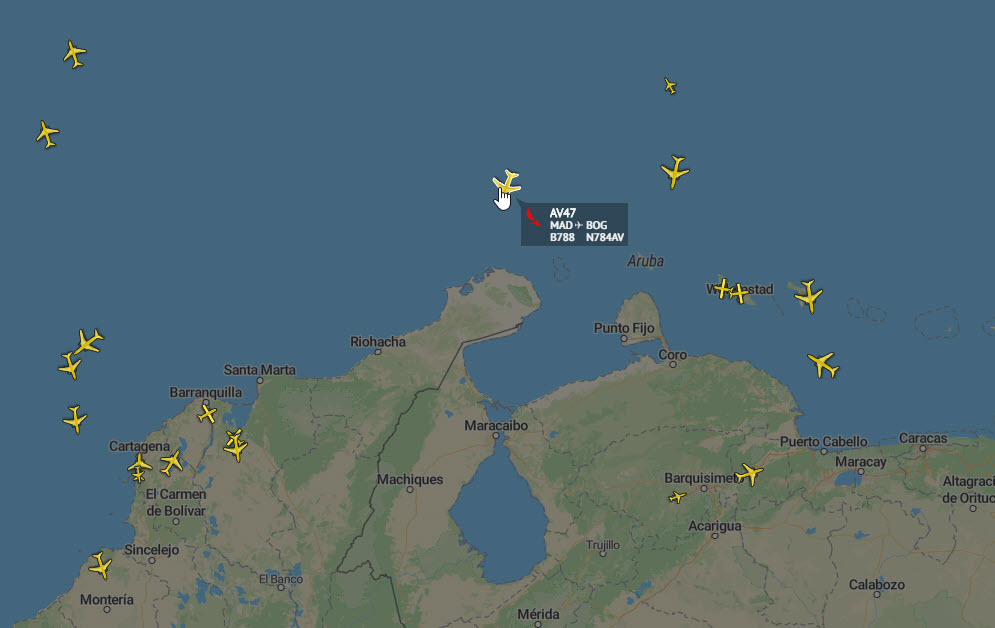
Hovering your cursor over an aircraft on Radar Box’s default interface will show you important information about the flight, including the aircraft type and destination/arrival cities. In this image, we can see that the aircraft is Avianca’s AV47 (Madrid to Bogota), that it is a Boeing 787-8, and that its registration is N784AV
Flight Aware (www.flightaware.com)
Flight Aware is a great hub for all things commercial flight, including easy-to-access weather information for destinations around the world and an airport delay map accessible on the home page. The website also has an RSS feed (called “Squawks”) of industry news, a message board, and even an aircraft photograph section.
Flight Aware also allows you to get notifications whenever an aircraft of interest files a flight plan, departs/arrives from an airport, or if the flight is delayed/cancelled/diverted. These Flight Alerts allows for passive monitoring of flights, as all you have to do is add flights to your alert list and wait for the notifications to arrive in your e-mail inbox.
Paid Subscription? Yes, in tiers.
- Basic Plan (free): Three months of historical flight data, and five flight alerts.
- Premium+ ($39.95 per month): Five months of historical flight data, unlimited flight alerts, and extra map layer options.
- Enterprise ($89.95 per month): Eight months of historical flight data, ATC call signs, and no ads.
- Enterprise WX ($129.95 per month): Eight months of historical flight data, premium weather layers, and additional aircraft information.
Plane Finder (www.planefinder.net)
Plane Finder boasts an Aviation Database that includes a list of flights that have declared emergencies recently, which could help you get ahead of the news.
Like Flight Radar 24, Plane Finder also has a “Playback” feature that lets you watch a section of airspace as it appeared at some point in the past. The GIF below shows the feature in action over Bogota, Colombia on Wednesday, September 19:
Paid Subscription? Yes, in tiers.
- Free Tier: Live flight tracking and limited access to historical flight data.
- Paid Tier ($1.99 per month): 365 days’ of historical flight data and a “faster experience”.
ADS-B Exchange (adsbexchange.com)
ADS-B Exchange is a passion project run by hobbyists for hobbyists. For this reason, there are no paid tier subscriptions on the page. Instead, all the data that the platform receives is made available for free to all users. The website also prides itself in not removing flight information unless it is compelled to do so by a legal order, and in that event, it claims that it would to post a notice to users alerting them to the removal of the flight(s).
ADS-B Exchange is also great for tracking military and police aircraft (although not every single one of them, mind you), making it a particularly useful tool for live-monitoring geopolitical flashpoints and breaking news events. The website’s live map (found in the “Global Radar View” tab on the main page) offers a handy “Filter” feature that allows you to display only military aircraft:
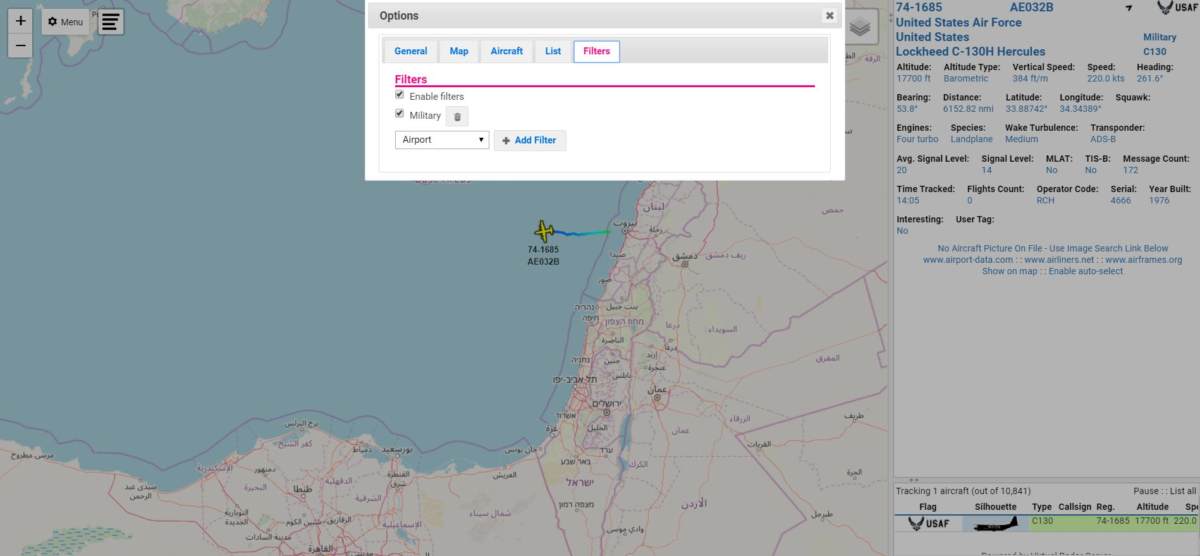
To filter the map to display only military aircraft, click the “Menu” button on the top left of the live traffic map. Then, click the “Filters” tab. Select “Military” from the drop-down menu, and then click “Enable Filters”. Seen here, a United States Air Force Lockheed C-130H Hercules over the eastern Mediterranean
Note: ADS-B Exchange also used to have free historical flight data but was forced to suspend the feature until further notice on October 6 2019 due to financial reasons.
Paid Subscription: None.
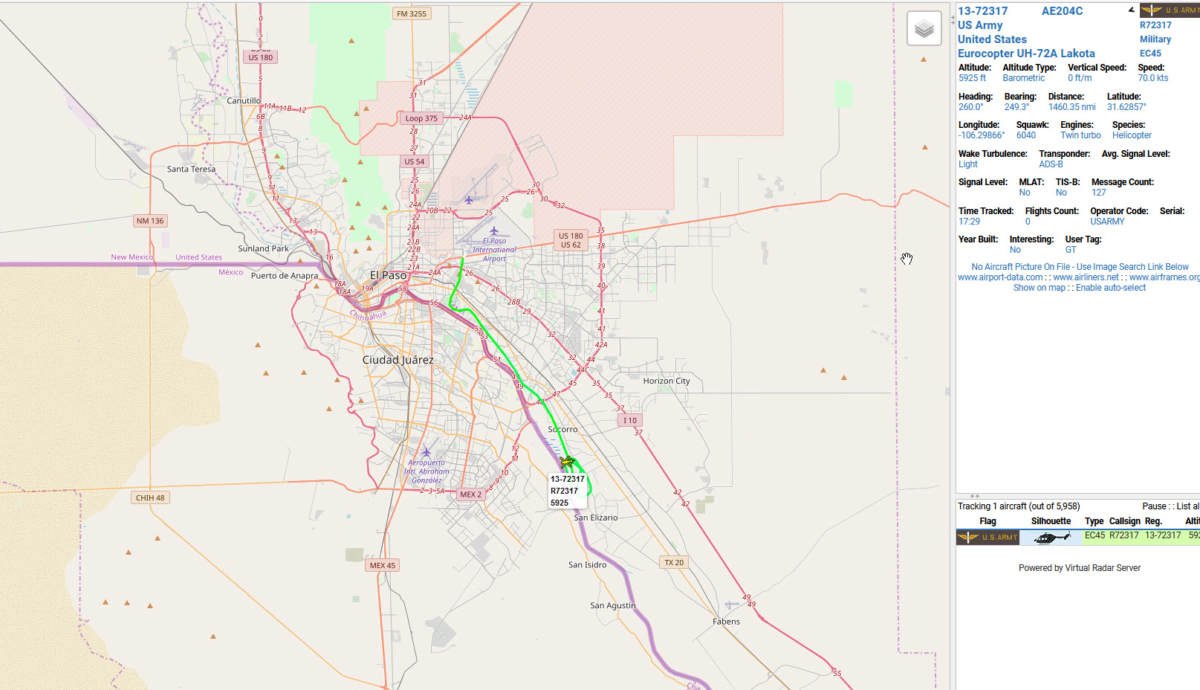
ADS-B Exchange also tracks some military aircraft. Seen here, a US Army UH-72A Lakota helicopter flying near the Mexico border just south of El Paso, Texas
Filling in Gaps: Twitter and Plane Spotter Sites
Sometimes, the aircraft that you are looking for does not appear on any of the flight tracking websites listed above. Other times, you might find only a couple of flights on these pages. In order to fill in gaps in flight history, open source investigators have at their disposal two other tools: Twitter and plane spotter sites.
Twitter is full of individuals who spend a lot of their time tracking airplanes. Some of these individuals put a lot of care into cataloging the aircraft that they spot, be it on tracking websites or on the ground with their own cameras. In order to find information about an aircraft on Twitter, all you need to do is search for its registration. This will pull up any tweets including that aircraft’s registration.
For example, here is Aeromexico’s flight AM646 from Mexico City to Los Angeles when it is currently in the air. We can see that the aircraft’s registration is XA-ADH:
A search for that registration on Twitter pulls up tweets about that aircraft, two of which can be seen here and here.
As these examples show, Twitter can be a source not only of reference imagery for aircraft, but also of evidence that an aircraft was in a given location at a given time, even when the aircraft does not appear on any flight tracking websites.
Twitter is also not the only website that hobbyists and other enthusiasts use to upload pictures of airplanes. There are also planes potting sites like www.jetphotos.com, www.planespotters.net, and www.airliners.net where people can share pictures of airplanes taken all over the world. The pictures are usually of airplanes landing, taking off or just parked in an airport, which make them particularly handy for confirming whether an aircraft was in a given location at a given time. As with the other websites in this guide, it is always a good idea to search for the same airplane across the different sites.
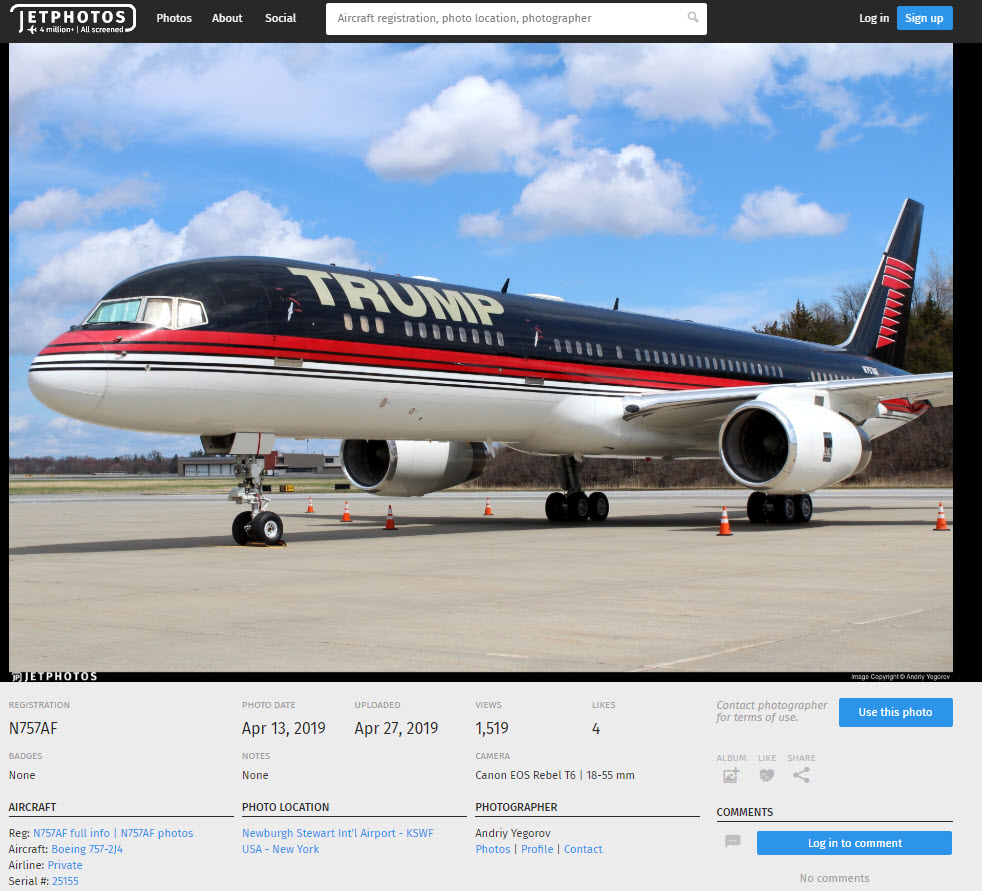
An example of an entry for Trump Force One (N575AF) on jetphotos.com. Note that the entry contains the aircraft’s MSN (if available), where the image was taken, and when
What if you want to confirm whether an aircraft is at an airport, and cannot wait for someone to snap a picture of it and share it on a plane spotter website? AirLive has links to webcams at airports around the world, and even matches them to their respective air traffic control transmissions so you can watch and listen in live.
Case Study: The Venezuelan Government’s (Not So) Secret Airplane
Let’s put these tools and knowledge to use by looking at a recent example.
On August 10, 2019, former Colombian president Andrés Pastrana tweeted that an airplane belonging to Venezuelan President Nicolas Maduro had recently traveled to Cuba, and that it was transporting Colombian guerrilla leaders as well as other individuals. While there was no open source information available to confirm who was flying in that airplane, flight tracking websites and other sources did allow people to check Pastrana’s claim that the airplane was in use by Venezuelan government authorities:
In his tweet, Pastrana identified the airplane in question as YV3016. Now that we know that this is the airplane’s registration, we can use any of the flight tracking websites in this guide to find out more information about it.
In this case, let’s use Flight Radar 24. To search for YV3016, we simply write the registration in the search bar on the top left of the live traffic screen:
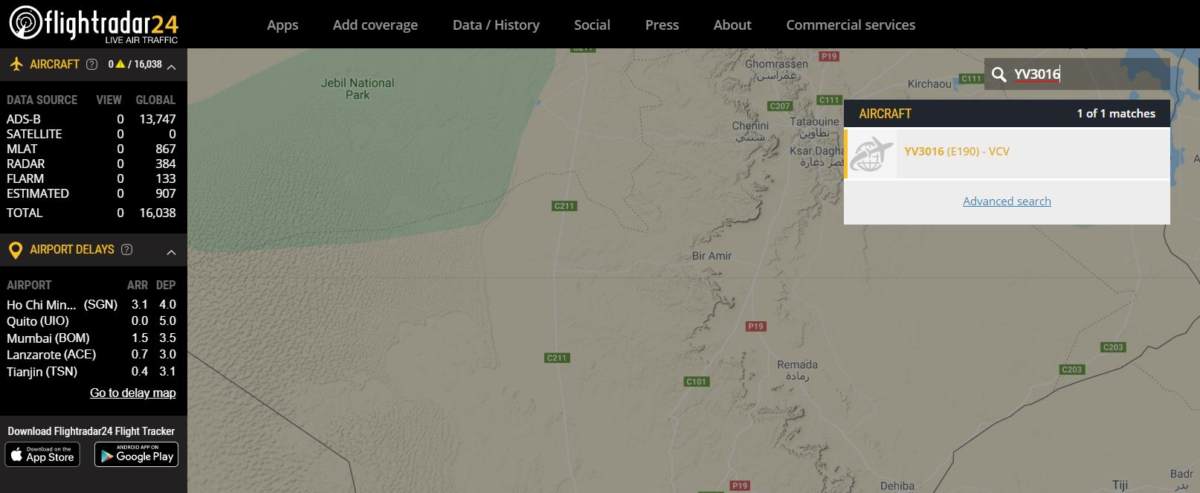
Note that the website tells us that it has record(s) for the aircraft by showing us a drop-down window below the search bar showing YV3016
Now, let’s look at what Flight Radar 24 tells us about YV3016:

Searching for the registration on Flight Radar 24 shows us pictures of YV3016, which company operates the aircraft, and that it is an Embraer Lineage 1000, as well as other information
The website tells us that YV3016 is registered to and operated by Conviasa, which is a Venezuelan state-owned commercial airline. This is evidenced not only by the text on the left side of the screen, but also by two images of YV3016 on the right of the screen as they appear on JetPhotos.com. These images show that the airplane’s livery (the aviation term for paint scheme) is that of any other Conviasa airplane.
However, a quick scan of the aircraft’s flight history raises some questions. We see that, for example, YV3016 flew from Caracas to Moscow on May 5, from Moscow to Istanbul on May 6, and from Istanbul to Caracas on May 7. A search of Conviasa’s website shows that the airline does not fly any of those routes. This suggests that YV3016 is in the personal use of an individual(s) who is making these trips abroad.

According to Flight Radar 24, YV3016 flew to Moscow on May 5, and then to Istanbul on May 7. However, Conviasa does not fly those routes
Searching for YV3016 on JetPhotos.com and PlaneSpotter.com shows images of the aircraft in other locations not serviced by Conviasa, including Las Palmas, The Hague, Lisbon and Geneva.
YV3016’s information page on Flight Radar 24 contains another crucial detail — the aircraft in question is an Embraer Lineage 1000, a luxury business jet.
Taken together, all this information is evidence that this luxury airplane registered to and painted to look to an ordinary Conviasa commercial airliner is, in fact, in private use. Given the fact that Conviasa is owned by the Venezuelan government, this suggests that it is used by Venezuelan government officials and VIPs to travel incognito around the world.
Are there any other aircraft disguised as Conviasa commercial airliners flying Venezuelan VIPs across the world? If so, how many, which ones, and where have they flown? Can we track YV3016’s movements in the future to get ahead of the news—that is, to find out where Venezuelan VIPs, including government officials, are going? Is this tactic in use by the governments of other countries?
With the information contained in this guide, you now have the tools and knowledge to investigate these questions and others for yourself!
Conclusion
From live traffic websites that offer historical data to plane spotting websites to Twitter, flight tracking is made possible due to the wealth of open source information available online. While flight tracking websites demand paid subscriptions for more data, the free and next-to-free tiers will usually provide a great deal of useful information. Whatever gaps in data these websites might have can be filled with other free resources, making creative thinking an important ability for open sources investigators looking to use these tools in their own work.
Thanks to Aram Shabanian for his help reviewing this guide! Aram is pursuing a Masters degree in Non-Proliferation and Terrorism Studies at the Middlebury Institute of International Studies. He specializes in military hardware and open-source research techniques, and can be reached on Twitter (@AramShabanian) and here: http://www.thefuldagap.com
